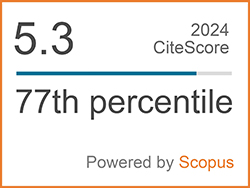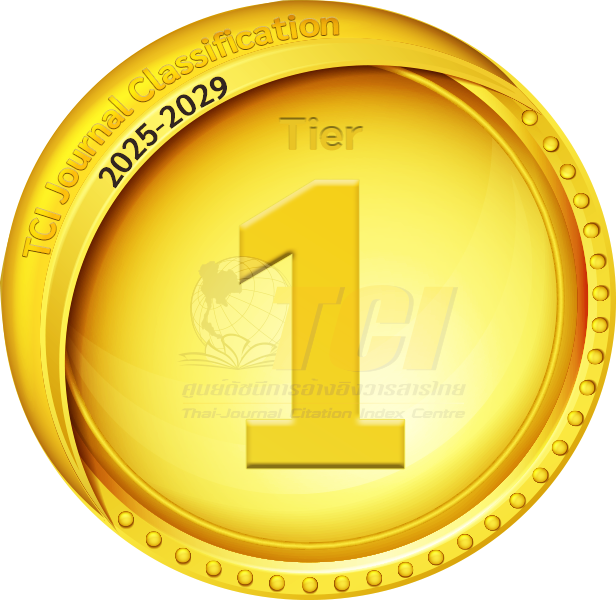Ferromagnetic Biochar Derived from Agricultural Waste of Musa acuminata for Adsorption of Dyes
Abstract
Keywords
[1] G. Enaime, A. Baçaoui, A. Yaacoubi, and M. Lübken, “Biochar for wastewater treatment-conversion technologies and applications,” Applied Sciences, vol. 10, no. 10, p. 3492, May 2020, doi: 10.3390/app10103492.
[2] A. E. Moharm, G. A. El-Naeem, H. M. A. Soliman, A. I. Abd-Elhamid, A. A. El-Bardan, T. S. Kassem, A. A. Nayl, and S. Bräse, “Fabrication and characterization of effective biochar biosorbent derived from agricultural waste to remove cationic dyes from wastewater,” Polymers, vol. 14, no. 13, p. 2587, 2022, doi: 10.3390/polym14132587.
[3] Q. Chen, Q. Zhang, Y. Yang, Q. Wang, Y. He, and N. Dong, “Synergetic effect on methylene blue adsorption to biochar with gentian violet in dyeing and printing wastewater under competitive adsorption mechanism,” Case Studies in Thermal Engineering, vol. 26, 2021, Art. no. 101099, doi: 10.1016/j.csite.2021.101099.
[4] Y. Zhang, P. Su, D. Weathersby, Q. Zhang, J. Zheng, R. Fan, J. Zhang, and Q. Dai, “Synthesis of γ-Fe2O3-ZnO-biochar nanocomposites for Rhodamine B removal,” Applied Surface Science, vol. 501, Jan. 2020, Art. no. 144217, doi: 10.1016/j.apsusc.2019.144217.
[5] S. Wang, Y. Ruan, L. Yi, D. Liu, J. Wang, D. Fang and Z. Zhang, “Investigation on intensified degradation of Rhodamine B and heat generation using a novel thermally assisted hydrodynamic cavitation device,” Journal of Environmental Chemical Engineering, vol. 10, Oct. 2022, Art. no. 108544, doi: 10.1016/j.jece.2022.108544.
[6] A. K. Pandey, R. R. Kumar, B. Kalidasan, I. A. Laghary, M. Samykano, R. Khotari, A. M. Abusorrah, K. Sharma and V. V. Tyagi, “Utilization of solar energy for wastewater treatment: Challenges and progressive research trends,” Journal of Environmental Management, vol. 297, Jul. 2021, Art. no. 113300, doi: 10.1016/j.jenvman.2021.113300
[7] C. Kosaiyakanon, and S. Kungsanant, “Adsorption of Reactive Dyes from Wastewater Using Cationic Surfactant-modified Coffee Husk Biochar,” Environment and Natural Resources Journal, vol. 18, no. 1, pp. 21–32, 2020, doi: 10.32526/ennrj.18.1.2020.03.
[8] M. Lewoyehu “Comprehensive review on synthesis and application of activated carbon from agricultural residues for the remediation of venomous pollutants in wastewater,” Journal of Analytical and Applied Pyrolysis, vol. 159, Aug. 2021, Art. no. 105279, doi: 10.1016/j.jaap.2021. 105279
[9] J. Wu, J. Yang, P. Feng, G. Huang, C. Xu, and Lin B, “High-efficiency removal of dyes from wastewater by fully recycling litchi peel biochar,” Chemosphere, vol. 246, May. 2020, Art. no. 125734 doi: 10.1016/j.chemosphere. 2019.125734.
[10] J. Wang, and S. Wang, “Preparation, modification and environmental application of biochar: A review,” Journal of Cleaner Production, vol. 227, pp. 1002–1022, Aug. 2019, doi: 10.1016/j.jclepro.2019.04.282.
[11] Y. Xie, L. Wang, H. Li, L. J. Westholm, L. Carvalho, E. Thorin, Z. Yu, X. Yu and Ø. Skreiberg, “A critical review on production, modification and utilization of biochar,” Journal of Analytical and Applied Pyrolysis, vol. 161, Jan. 2022, Art. no. 125734, doi: 10.1016/j.jaap. 2021.105405.
[12] E. Viglašová, M. Galamboš, Z. Danková, L. Krivosudský, C. L. Lengauer, R. Hood-Nowotny, G. Soja, A. Rompel, M. Matík, and J. Briančin “Production, characterization and adsorption studies of bamboo-based biochar/ montmorillonite composite for nitrate removal,” Waste Management, vol. 79, pp. 385–394, Sep. 2018, doi: 10.1016/j.wasman.2018.08.005.
[13] C. A. Odega, O. O. Ayodele, S. O. Ogutuga, G. T. Anguruwa, A. E. Adekunle, and C. O. Fakorede, “Potential application and regeneration of bamboo biochar for wastewater treatment: A review,” Advances in Bamboo Science, vol. 2, Feb. 2023, Art. no. 100012, doi: 10.1016/j.bamboo.2022.100012.
[14] K. Chaturvedi, A. Singhwane, M. Dhangar, M. Mili, N. Gorhae, A. Naik, N. Prashant, A. K. Srivastava, and S. Verma, “Bamboo for producing charcoal and biochar for versatile applications,” Biomass Conversion and Biorefinery, vol. 14, pp. 15159–15185, Feb. 2024, doi: 10.1007/s13399-022-03715-3.
[15] X. Hu, X. Zhang, H. H. Ngo, W. Guo, H. Wen, C. Li, Y. Zhang, C. Ma, “Comparison study on the ammonium adsorption of the biochars derived from different kinds of fruit peel,” Science of The Total Environment, vol. 707, Mar. 2020, Art. no. 135544, doi: 10.1016/j.scitotenv. 2019.135544.
[16] A. Flammini, E. Brundin, R. Grill, and H. Zellweger, “Supply Chain Uncertainties of Small-Scale Coffee Husk-Biochar Production for Activated Carbon in Vietnam,” Sustainability, vol. 12, no. 19, p. 8069, Sep. 2020, doi: 10.3390/su12198069
[17] Y. Cao, G. Shen, Y. Zhang, C. Gao, Y. Li, P. Zhang, W. Xiao, and L. Han, “Impacts of carbonization temperature on the Pb(II) adsorption by wheat straw-derived biochar and related mechanism,” Science of The Total Environment, vol. 692, pp. 479–489, Nov. 2019, doi: 10.1016/j.scitotenv.2019.07.102.
[18] T. Ai, X. Jiang, Q. Liu, L. Lv, and H. Wu, “Daptomycin adsorption on magnetic ultra-fine wood-based biochars from water: Kinetics, isotherms, and mechanism studies,” Bioresource Technology, vol. 273, pp. 8–15, Feb. 2019, doi: 10.1016/j.biortech.2018.10.039.
[19] X. Li, Y. Cao, J. Xia, M. M. Abdus Salam and G. Chen, “Bamboo biochar greater enhanced Cd/Zn accumulation in Salix psammophila under non‑flooded soil compared with flooded,” Biochar, vol. 4, no. 7, Feb. 2022, doi: 10.1007/ s42773-022-00139-0.
[20] J. Su, Z. Guo, M. Zhang, Y. Xie, R. Shi, X. Huang, Y. Tuo, X. He and P. Xiang, “Mn-modified bamboo biochar improves soil quality and immobilizes heavy metals in contaminated soils,” Environmental Technology & Innovation, vol. 34, Apr. 2024, Art. no 103630, doi: 10.1016/ j.eti.2024.103630.
[21] A. Emamverdian, A. Ghorbani, N. Pehlivan, Y. Li, M. Zargar and G. Liu, “Bamboo biochar helps minimize Brassica phytotoxicity driven by toxic metals in naturally polluted soils of four mine zones,” Environmental Technology & Innovation, vol. 36, Jul. 2024, Art. no. 103753, doi: 10.1016/j.eti.2024.103753.
[22] Z. T. Hu, Y. Ding, Y. Shao, L. Cai, Z. Y. Jin, Z. Liu, J. Zhao, F. Li, Z. Pan, X. Li and J. Zhao, “Banana peel biochar with nanoflake-assembled structure for cross contamination treatment in water: Interaction behaviors between lead and tetracycline,” Chemical Engineering Journal, vol. 420, Apr. 2021, Art. no. 129807, doi: 10.1016/j.cej.2021.129807.
[23] M. A. El-Nemra, M. Yılmaz, S. Ragab and A. El-Nemr, “Watermelon peels biochar-S for adsorption of Cu2+ from water,” Desalination and Water Treatment, vol. 261, pp. 195–213, Jun. 2022, doi: 10.5004/dwt.2022.28506.
[24] R. Foroutan, S. J. Peighambardoust, S. Ghojavand, S. Farjadfard and B. Ramavandi, “Cadmium elimination from wastewater using potato peel biochar modified by ZIF-8 and magnetic nanoparticle,” Colloid and Interface Science Communications, vol. 55, May. 2023, Art. no. 100723, doi: 10.1016/j.colcom.2023. 100723.
[25] Y. Zhaoa, X. Heb, K. Qib, A. Zadac and Jing Pan, “Study on the adsorption of phosphate over biochar-based adsorbents from peanut shell and orange peel in water,” Desalination and Water Treatment, vol. 308, pp. 102–109, Oct. 2023, doi: 10.5004/dwt.2023.29810.
[26] Y. Zhou, J. Wang, M. Sun, W. Li and X. Hu, “Adsorption of CO2 by nitrogen doped corn straw based biochar,” Arabian Journal of Geosciences, vol. 14, Aug. 2021, Art. no. 1875, doi: 10.1007/s12517-021-08224-7.
[27] C. K. C. Cabriga, K. V. B. Clarete, J. A. T. Zhang, R. M. P. Pacia, Y. S. Ko and J. C. Castro, “Evaluation of biochar derived from the slow pyrolysis of rice straw as a potential adsorbent for carbon dioxide,” Biomass Conversion and Biorefinery, vol. 13, pp. 7887–7894, Jun. 2021, doi: 10.1007/s13399-021-01719-z.
[28] A. Peter, B. Chabot and E. Loranger, “Enhanced activation of ultrasonic pre-treated softwood biochar for efficient heavy metal removal from water,” Journal of Environmental Management, vol. 290, Apr. 2021, Art. no. 112569, doi: 10.1016/j.jenvman.2021.112569.
[29] S. Chandra, I. Medha, J. Bhattacharya, K. R. Vanapalli and B. Samal, “Effect of the Co-Application of Eucalyptus Wood Biochar and Chemical Fertilizer for the Remediation of Multimetal (Cr, Zn, Ni, and Co) Contaminated Soil,” Sustainability, vol. 14, no. 12, p. 7266, Apr. 2022, doi: 10.3390/su14127266.
[30] Y. Sun, B. Dong, L. Wang, H. Li and E. Thorin, “Technology selection for capturing CO2 from wood pyrolysis,” Energy Conversion and Management, vol. 266, May. 2022, Art. no. 115835, doi: /10.1016/j.enconman.2022.115835.
[31] S. E. Guapacha, M. Salazar, J. Aguillón, and P. Landázuri, “Similaridad cariotípica entre diversas variedades de Musa spp del Quindío-Colombia,” Cultivos Tropicales, vol. 38, no. 4, pp. 119-126, Oct. 2017.
[32] I. Cabeza, M. Thomas, A. Vasquez, P. Acevedo, and M. Hernandez, “Anaerobic Co-digestion of Organic Residues from Different Productive Sectors in Colombia: Biomethanation Potential Assessment,” Chemical Engineering Transactions, vol. 49, pp. 385–390, May. 2016, doi: 10.3303/ CET1649065.
[33] M. T. Amin, A. A. Alazba, and M. Shafiq, “Comparative study for adsorption of methylene blue dye on biochar derived from orange peel and banana biomass in aqueous solutions,” Environmental Monitoring and Assessment, vol. 191, Nov. 2019, Art. no. 735, doi: 10.1007/ s10661-019-7915-0.
[34] R. T. Kapoor, M. Rafatullah, M. R. Siddiqui, M. A. Khan, and M. Sillanpää “Removal of reactive black 5 dye by banana peel biochar and evaluation of its phytotoxicity on tomato,” Sustainability, vol. 14, no. 7, p. 4176, Mar. 2022, doi: 10.3390/su14074176.
[35] S. Daffalla, A. Taha, E. Da’na and M. R. El-Aassar, “Sustainable banana-waste-derived biosorbent for congo red removal from aqueous solutions: Kinetics, equilibrium, and breakthrough studies,” Water, vol. 16, no. 10, p. 1449, May. 2024, doi: 10.3390/w16101449.
[36] F. Fuentes-Gandara, I. Piñeres-Ariza, A. Zambrano-Arevalo, G. Castellar-Ortega, C. Herrera-Herrera, S. Castro-Muñoz, G. Peluffo-Foliaco and J. Pinedo-Hernández, “Removal of direct navy blue dye from aqueous solutions using banana peels,” Global Journal of Environmental Science and Management, vol. 10, no. 3, pp. 1067–1084, Apr. 2024, doi: 10.22034/gjesm.2024.03.09.
[37] B. Sajjadi, R. M. Shrestha, W. Y. Chen, D. L. Mattern, N. Hammer, V. Raman and A. Dorris, “Double-layer magnetized/functionalized biochar composite: Role of microporous structure for heavy metal removals,” Journal of Water Process Engineering, vol. 39, Feb. 2021, Art. no. 101677, doi: 10.1016/j.jwpe.2020.101677.
[38] M. D. Gillingham, R. L. Gomes, R. Ferrari and H. M. West, “Sorption, separation and recycling of ammonium in agricultural soils: A viable application for magnetic biochar?,” Science of the Total Environment, vol. 812, Mar. 2022, Art. no. 151440, doi: 10.1016/j.scitotenv.2021.151440.
[39] A. Tomczyk, Z. Sokołowska and P. Boguta, “Biochar physicochemical properties: Pyrolysis temperature and feedstock kind effects,” Reviews in Environmental Science and Bio/Technology, vol. 19, pp. 191–215, Feb. 2020, doi: 10.1007/ s11157-020-09523-3.
[40] A. Bopda, S. G. Mokue Mafo, J. N. Ndongmo, G. T. Kenda, C. G. Fotsop, I. H. Tiotsop Kuete, C. S. Ngakou, D. R. Tchuifon Tchuifon, A. Tamo A, G. N. A. Nche, and S. G. Anagho SG, “Ferromagnetic biochar prepared from hydrothermally modified calcined mango seeds for fenton-like degradation of indigo carmine,” C, vol. 8, no. 4, p. 81, Dec. 2022, doi: 10.3390/ c8040081.
[41] R. Isaac and S. Siddiqui, “Sequestration of Ni(II) and Cu(II) using FeSO4 modified Zea mays husk magnetic biochar: Isotherm, kinetics, thermodynamic studies and RSM,” Journal of Hazardous Materials Advances, vol. 8, Sep. 2022, Art. no. 100162, doi: 10.1016/j.hazadv. 2022.100162.
[42] A. Y. Elnour, A. A. Alghyamah, H. M. Shaikh, A. M. Poulose, S. M. Al-Zahrani, A. Anis, and M. I. Al-Wabel, “Effect of pyrolysis temperature on biochar microstructural evolution, physicochemical characteristics, and its influence on biochar/polypropylene composites,” Applied Sciences, vol. 9, no. 6, p. 1149, Mar. 2019, doi: 10.3390/app9061149.
[43] R. Janu, V. Mrlik, D. Ribitsch, J. Hofman, P. Sedláček, L. Bielská, and G. Soja, “Biochar surface functional groups as affected by biomass feedstock, biochar composition and pyrolysis temperature,” Carbon Resources Conversion, vol. 4, p.p. 36–46, 2021, doi: 10.1016/j.crcon. 2021.01.003.
[44] L. Suárez-Hernández, A.N. Ardila-A, and R. Barrera-Zapata, “Morphological and physicochemical characterization of biochar produced by gasification of selected forestry species,” Revista Facultad de Ingeniería, vol. 26, no. 46, pp. 123–130, Sep. 2017, doi: 10.19053/ 01211129.v26.n46.2017.7324.
[45] T. Yang, J. Meng, P. Jeyakumar, T. Cao, Z. Liu, T. He, X. Cao, W. Chen, and H. Wang “Effect of pyrolysis temperature on the bioavailability of heavy metals in rice straw-derived biochar,” Environmental Science and Pollution Research, vol. 28, no. 2, pp. 2198–2208, Sep. 2020, doi: 10.1007/s11356-020-10193-5.
[46] M. Wu, Q. Feng, X. Sun, H. Wang, G. Gielen, and W. Wu, “Rice (Oryza sativa L) plantation affects the stability of biochar in paddy soil,” Scientific Reports, vol. 5, May 2015, Art. no. 10001, doi: 10.1038/srep10001.
[47] V. Rouchon, H. Badet, O. Belhadj, O. Bonnerot, B. Lavédrine, J. G. Michard, and S. Miska, “Raman and FTIR spectroscopy applied to the conservation report of paleontological collections: identification of Raman and FTIR signatures of several iron sulfate species such as ferrinatrite and sideronatrite,” Journal of Raman Spectroscopy, vol. 43, pp. 1265–1274, Jun. 2012, doi: 10.1002/jrs.4041.
[48] T. A. Saleh, and A. A. Al-Saadi, “Surface characterization and sorption efficacy of tire-obtained carbon: experimental and semiempirical study of rhodamine B adsorption,” Surface and Interface Analysis, vol. 47, pp. 785–792, May. 2015, doi: 10.1002/sia.5775.
[49] C. H. Chio, S. K. Sharma, and D. W. Muenow, “The hydrates and deuterates of ferrous sulfate (FeSO4): a Raman spectroscopic study,” Journal of Raman Spectroscopy, vol. 38, pp. 87–99, Sep. 2007, doi: 10.1002/jrs.1623.
[50] O. V. Ovchinnikov, A. V Evtukhova, T. S. Kondratenko, M. S. Smirnov, Y. V. Khokhlov, and O. V. Erina, “Manifestation of intermolecular interactions in FTIR spectra of methylene blue molecules,” Vibrational Spectroscopy, vol. 86, pp. 181–189, Sep. 2016, doi: 10.1016/j.vibspec.2016.06.016.
[51] W. Rao, P. Piliouras, X. Wang, A. Guido, K. Kugler, B. Sieren, L. Wang, G. Lv, Z. Li, “Zwitterionic dye rhodamine B (RhB) uptake on different types of clay minerals,” Applied Clay Science, vol. 197, Nov. 2020, Art. no. 105790, doi: 10.1016/j.clay.2020.105790.
[52] C. Li, Y. Huang, K. Lai, B. A. Rasco, and Y. Fan “Analysis of trace methylene blue in fish muscles using ultra-sensitive surface-enhanced Raman spectroscopy,” Food Control, vol. 65, pp. 99–105, Jul. 2016, doi: 10.1016/j.foodcont.2016.01.017.
[53] K. T. Tu, and C. K. Chung, “Enhancement of Surface Raman Spectroscopy Performance by Silver Nanoparticles on Resin Nanorods Arrays from Anodic Aluminum Oxide Template,” Journal of The Electrochemical Society, vol. 164, no. 5, pp. B3081–B3086, Jan. 2017, doi: 10.1149/2.0121705jes.
[54] S. Lin, W. L. J. Hasi, X. Lin, S. Han, X. T. Lou, F. Yang, D. Y. Lin, and Z. W Lu, “Rapid and sensitive SERS method for determination of Rhodamine B in chili powder with paper-based substrates,” Analytical Methods, vol. 7, pp. 5289–5294, May 2015, doi: 10.1039/C5AY00028A.
[55] R. Wolski, A. Bazan-Wozniak, A. Nosal-Wiercinska and R. Pietrzak, “Methylene blue and rhodamine B dyes’ efficient removal using biocarbons developed from waste,” Molecules, vol. 29, no. 17, p. 4022, Aug. 2024, doi: 10.3390/molecules29174022.
[56] U. Kumar, B. Vibhute, N. Sharma and A. Sahay, “Efficient removal of methylene blue dye by alkaline-treated banana stem biochar through adsorption method,” Applied Ecology and Environmental Sciences, vol. 10, no. 4, pp. 236–243, Apr. 2022, doi: 10.12691/aees-10-4-8.
[57] A. F. Alharbi, A. A. Alotaibi, H. E. M. Gomaa, A. A. M. Abahussain, and S. M. A. Azeem, “Magnetic biochar by one-step impregnation pyrolysis of Peganum harmala L. for removal of rhodamine B,” Adsorption Science & Technology, vol. 2023, Aug. 2023, doi: 10.1155/ 2023/9993465.
[58] S. Nirmaladevi, and N. Palanisamy, “A comparative study of the removal of cationic and anionic dyes from aqueous solutions using biochar as an adsorbent,” Desalination and Water Treatment, vol. 175, pp. 282–292, Jan. 2020, doi: 10.5004/dwt.2020.24906.DOI: 10.14416/j.asep.2025.06.004
Refbacks
- There are currently no refbacks.
 Applied Science and Engineering Progress
Applied Science and Engineering Progress







